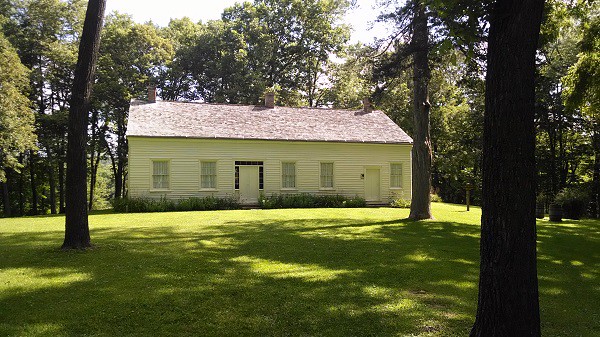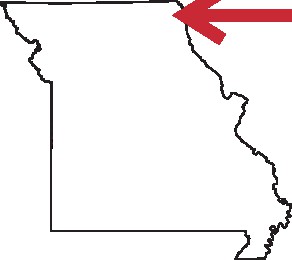Learn how the site of an early Civil War skirmish became a State Historic Site. Uncover prehistoric Indian sites and part of a Sauk Indian village. Take a hike to see rich flora that are relics of glacial times. Can you find the “cannonball house?”

A BATTLE RAGED between strong-willed and passionate partisan Missourians in Clark County on August 5, 1861. It was one of the earliest skirmishes and perhaps the farthest north of the Civil War. When the smoke cleared, there were a few dozen casualties and the pro-South forces were in retreat, but the big loser was the town, where bitter feelings remained long after the war.
One hundred years after the battle, the Athens Park Development Association organized and began purchasing land to commemorate the battle, an idea that had been promoted ever since 1900 when local residents held the first of a nearly annual series of August 5 celebrations. The new association wanted the state to develop the property, but the Missouri State Park Board demurred on the grounds that the site did not have high priority for preservation. Undaunted, the association continued to acquire tracts, financed with the proceeds from motorcycle hill climbs it staged annually up a steep embankment along the river.
It was not until 1975 that the state accepted the 235-acre donation, and then as a park rather than a historic site. With a 10-acre lake for swimming, excellent fishing on the river, and a good place for a campground, the property could provide much-needed recreation facilities in a corner of the state relatively deficient in public lands. Then in 1981, in the course of an archaeological survey for a water-line across the park to the new campground, several discoveries changed the perception of the area. Archaeologists found a number of prehistoric Indian sites and part of a large historic Sauk Indian village that had been occupied as late as the 1830s. They also found evidence of nearly the entire site of Athens as laid out in 1844 by Isaac Gray in nine blocks of eight lots each. Still standing were the Smith Hotel and three houses, but of the fifty or so businesses operating before the Civil War, little remained except for the stone foundation of the grist, saw, and woolen mill down by the river.

With a wealth of structural remains and substantial archaeological and archival potential, park officials in 1985 decided to reclassify Battle of Athens as a historic site and began an ambitious research and development plan that has brought the site to more than 400 acres.
Archaeology has now exposed old foundations and roads, which are being stabilized, slightly reconstructed, or outlined on the ground for guiding visitors on a full-size map of the town. State park naturalists identified outstanding and unique natural features in the forested ravines along the Des Moines River northwest of the town. The ravines adjoin an upland area of former glacial-loessprairie being restored to reveal an unusually tight transition from open prairies to oak woodland to dense forest to riparian cottonwoods, a combination that surely attracted the Sauk and other native peoples as well as white settlers. A forty-acre site, protected as the Des Moines River Ravines Natural Area, is accessible via a two-mile loop trail.

The Civil War is still vitally important here, and we can explore the war’s impact on ordinary people caught in a vortex of change in this seemingly ordinary little river town.
A cannonball ripped through the Thome-Benning home at this historic site. The restoration of the home preserved the original hole right next to the kitchen door, earning the home the name “the cannonball house.”
The historic site offers camping, fishing, hiking, a picnic area, boating, and a playground.

409 acres
Clark County
Route CC, Revere, MO
Trails
• Mill Trail (0.3 mi)
• Snow Trillium Trail (2 mi)
Read about 28 Native American Sites in Missouri here.
Related Posts
Royal Smoke House BBQ
On February 18, 1927, The Weston Chronicle reported that the Royal Smoke House had a new brick oven out back and would be preparing barbequed meats – especially pork ribs, which had become very popular in the last few years.
LIVING COLOR: The Henry Blosser House
Henry Blosser was three generations removed from his Swiss ancestors, but that didn’t stop the nineteenth-century land speculator from celebrating his heritage when he and his wife, Sarah, built their dream home in 1878 on 640 acres near the town of Malta Bend.
The Blosser family came and went, and time leeched away the color and life from the home. A restoration of historic proportions is now complete.
Henry Blosser House and Barn photo slideshow
The Henry Blosser House and Barn near Malta Bend had been abandoned and neglected for years when new owners Dr. Art and Carolyn Elman stepped in to preserve these architectural treasures. The project, led by acclaimed interior designer Kelee Katillac, took years of painstaking effort by a team of preservation experts. The result is a masterpiece where conscientious conservation and spectacular design intersect.



